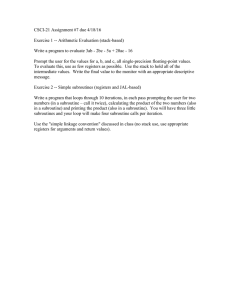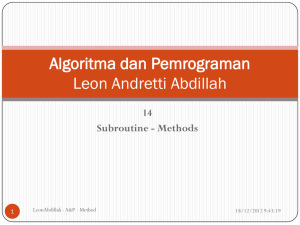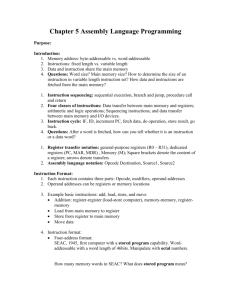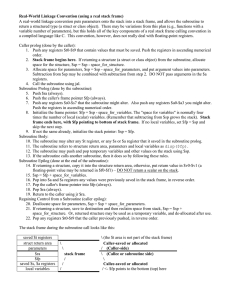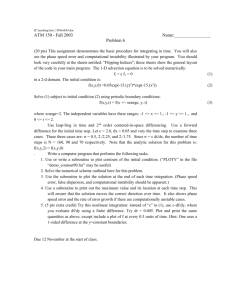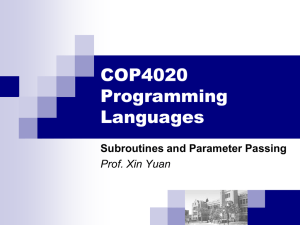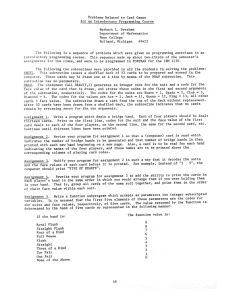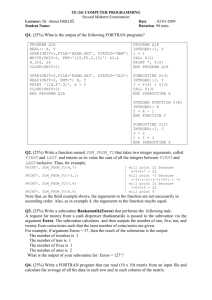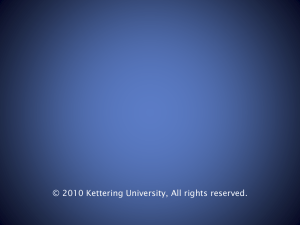LECTURE 19 Subroutines and Parameter Passing
advertisement
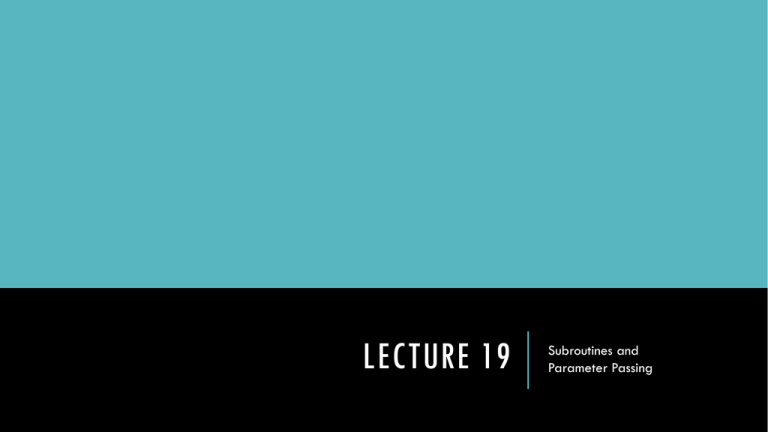
LECTURE 19
Subroutines and
Parameter Passing
ABSTRACTION
Recall:
• Abstraction is the process by which we can hide larger or more complex code
fragments behind a simple name.
• Data abstraction: hide data representation details.
• Control abstraction: create a well-defined operation by hiding execution details.
SUBROUTINES
Subroutines are the principle method of control abstraction in most languages.
• Subroutines are executed on behalf of a caller to whom the subroutine returns when
it is finished.
• Parameterized: caller provides subroutine with arguments which influence execution of
subroutine.
• Actual parameters: actual arguments passed in a subroutine call instance.
• Formal parameters: aliases for actual parameters within the subroutine.
• Functions: subroutines that return values (typically).
• Procedures: subroutines that do not return values.
SUBROUTINE FRAME
• An activation record (subroutine frame)
is used to store all related information
for the execution of a subroutine.
• Before a subroutine is executed, the
frame must be set up and some fields
in the frame must be initialized.
• Formal arguments must be replaced
with actual arguments.
• This is done in the calling sequence, a
sequence of instructions before and
after a subroutine, to set-up the frame.
Temporary storage
(e.g. for expression
evaluation)
Local variables
Bookkeeping
(e.g. saved CPU
registers)
Return address
Subroutine
arguments and
returns
SUBROUTINE FRAME
• With stack allocation, the subroutine
frame for the current frame is on top
of the stack.
• Stack pointer (sp): top of the stack.
• Frame pointer (fp): an address within
the top frame.
• To access non-local variables, a static
link (for static scoping) or a dynamic
link (dynamic scoping) is maintained in
the frame.
CALLING SEQUENCES
• Maintenance of the subroutine call stack is the responsibility of the calling sequence.
• In general, calling sequences have three components:
• The code executed by the caller immediately before and after a subroutine call.
• Prologue: code executed at the beginning of the subroutine itself.
• Epilogue: code executed at the end of the subroutine itself.
Calling Sequence Code
…
F(a, b);
…
Call F
Calling Sequence Code
Prologue
Body of F
Epilogue
CALLING SEQUENCES
What needs to be done in the calling sequence?
Before the subroutine code can be executed, we need to set up the subroutine frame (calling
code before the subroutine call + prologue). Generally speaking, the steps are:
• Compute the parameters and pass the parameters.
• Save the return address.
• Change the program counter.
• Change sp to allocate space for new frame.
• Save registers, including fp, which may be overwritten by subroutine.
• Change fp to allocate new frame.
• Execute initialization code when needed for objects in new frame, if needed.
CALLING SEQUENCES
What needs to be done in the calling sequence?
After the subroutine code is executed, remove the subroutine frame (calling code
after the subroutine + epilogue). Generally speaking, the steps are:
• Pass return parameters or function value.
• Finalization code for local objects.
• Deallocate the stack frame (restore fp and sp to their previous values).
• Restore saved registers and program counter.
CALLING SEQUENCES
Some of the operations must be performed by the caller, while others can either be
done by the caller or callee.
For example, passing parameters must be done by the caller because the parameters
passed will differ every time a call is made.
In general, it’s better to have set-up and tear-down operations performed by the
callee as much as possible. This cuts down on code generated for subroutine calling as
it only needs to appear once in the target program. On the other hand, any tasks
that the caller is responsible for appear at every call site.
SAVING AND RESTORING REGISTERS
• Some registers such as sp and fp are clearly different in and out of a subroutine.
• For general purpose registers used in the caller and/or callee:
main(){
…
R1 = 10
…
call foo();
…
R2 = R1
}
foo(){
R1= 20
}
• To execute correctly, R1 needs to be saved before foo() and restored after the
subroutine returns.
SAVING AND RESTORING REGISTERS
• The compiler should generate code only to save and restore registers that matter.
• If a subroutine does not use R3, R3 does not need to be saved in the calling sequence.
• Ideally, we should only save registers that are used in both the caller and the callee.
• Difficult due to separate compilation: no information about callee when compiling caller, and vice
versa.
• Simple solution (with unnecessary save/restore):
• Option 1: caller saves/restores all registers it uses
• Option 2: callee saves/restores all registers it uses
• Compromise: partition registers into two sets, one for the caller to save and one for
the callee to save.
SAVING AND RESTORING REGISTERS
Solution 1: Save/restore in the
calling sequence of caller.
main()
{
…
R1=10
…
T1 = R1
call foo();
R1 = T1
…
R2 = R1
}
Solution 2: Save/restore in
prologue and epilogue of callee.
foo()
{
T1 = R1
…
R1=20
…
R1 = T1
return
}
SAVING AND RESTORING REGISTERS
• MIPS and x86 processors implement the following compromise: non-special-purpose
registers are divided into two sets of roughly equal size. One set is the caller’s
responsibility, the other set is the callee’s responsibility.
• A callee assumes there is nothing of value in the caller-saved set.
• A caller assumes the callee will not destroy the contents of the callee-saved set.
A TYPICAL CALLING SEQUENCE
Caller before the call:
1. Save any caller-saved registers whose values will be needed after the call.
2. Compute the values of arguments and move them into the stack or registers.
3. Compute the static link, and pass it as an extra hidden argument.
4. Use a special subroutine call instruction to jump to the subroutine, simultaneously passing the
return address on the stack or in a register.
Prologue in the callee:
1. Allocate a frame (sp = sp – offset).
2. Save old fp on the the stack, update the fp.
3. Save callee-saved registers that may be overwritten in the routine.
Epilogue in the callee:
1. Move the return value into a register or a location on the stack.
2. Restore callee-saved registers.
3. Restore fp and sp.
4. Jump back to the return address.
Caller after the call:
1. Move the return value to wherever it is needed.
2. Restore caller-saved registers.
QUESTION
Why do local variables typically not have a default value (while globals do)?
int i;
int main(){
int j;
cout << i << j;
}
ANSWER
Global variables (and statics) are allocated a fixed section of memory at compile
time so initializing them to zero incurs no real runtime overhead – it’s a one-time deal
when the program is loaded into memory.
Local variables, however, may have a different address on the stack every single
time they are called which would require a new initialization step every single time
space was made for them. It’s easier to just leave it up to the programmer to
explicitly request some value.
REGISTER WINDOWS
An example of hardware support for efficient subroutine execution is Register
Windows.
• Introduced in Berkeley RISC machines.
• Also used in Sun SPARC and Intel Itanium processors.
• Maintain multiple sets (a window) of ISA registers using a much larger collection of
physical registers.
• Use a new mapping (set) of registers when making subroutine calls.
• Setting and resetting a mapping is cheaper than saving and restoring registers.
• New and old mapping registers overlaps to allow parameter passing.
IN-LINE FUNCTIONS
An example of language support for efficient subroutine execution is in-line functions.
• In C/C++: inline int max(int a, int b) {return a> b ? a: b;}
• Such functions are not real functions, the routine body is expanded in-line at the point of call.
• A copy of the routine body becomes a part of the caller.
• No actual routine call occurs.
• Will inline function always improve performance? Maybe, maybe not.
• Many other factors: e.g. code size affecting cache/memory behavior.
• Most compilers decide on their own whether to use in-line or call conventionally.
